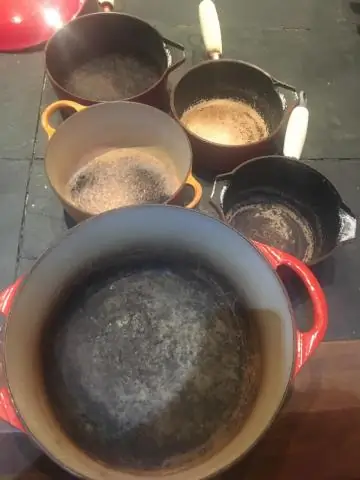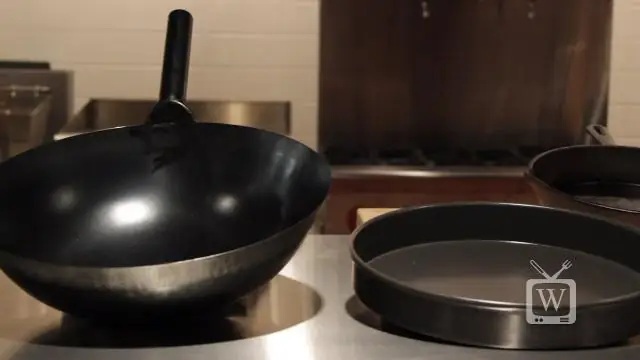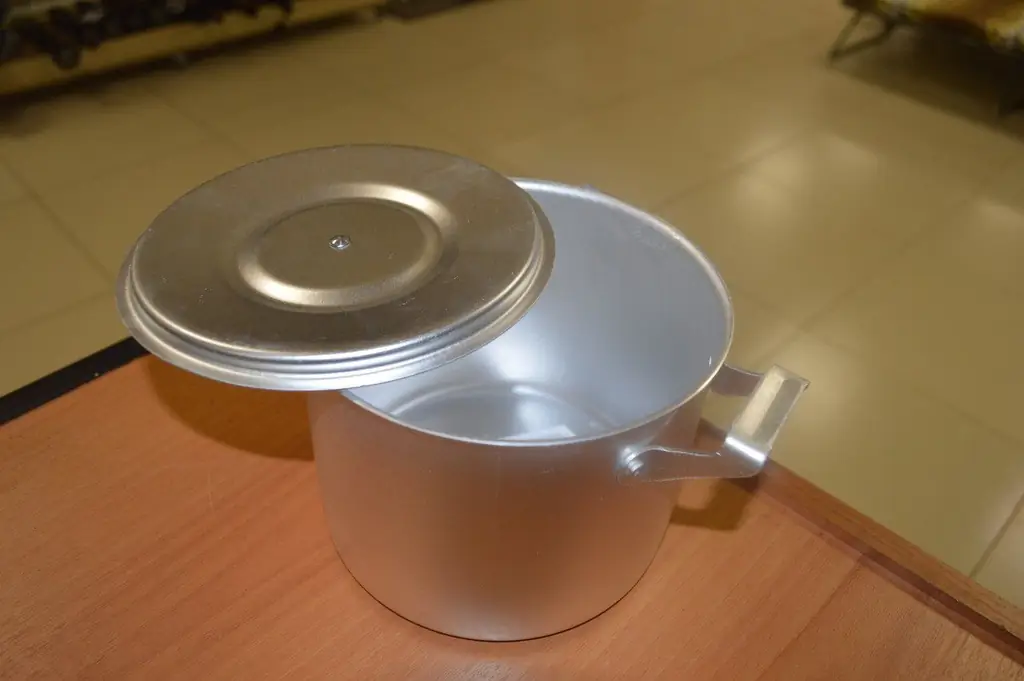
Table of contents:
- Author Bailey Albertson [email protected].
- Public 2024-01-17 22:26.
- Last modified 2025-06-01 07:32.
How to properly care for enamel pans

Each housewife has enameled dishes in the kitchen. It is environmentally friendly, durable, easy to clean. New pans look very elegant and neat, many have a heat-resistant design. But over time, with improper use and care, the original appearance is lost. The pan darkens, becomes covered with cracks, chips appear on the enamel. How to clean a burnt-out enamel pot while maintaining the finish?
Content
- 1 Types of contamination of an enamelled pan, ways to eliminate them
-
2 How to remove the burn on the pan from the inside and outside
- 2.1 Trying to clean the bottom of the pan from burnt porridge
- 2.2 Everyday quick dishwashing with mustard powder
- 2.3 How to get rid of darkening and yellowness with onions, sour apples or pears
- 2.4 Wash off dark deposits using milk whey
-
3 Effective remedies for stubborn dirt
- 3.1 Table salt or brine
- 3.2 Baking soda
- 3.3 Table vinegar 9% (apple, wine, alcohol)
-
3.4 Citric acid
3.4.1 Video: cleaning burnt enamel at home with citric acid
- 3.5 Photo Gallery: Devices for removing stubborn deposits
-
3.6 Cleaning with a mixture of baking soda, salt and vinegar
3.6.1 Video: how to effectively clean a pan from carbon deposits
- 3.7 How to remove milk burns with ground coffee
-
3.8 Activated carbon
3.8.1 Video: how you can clear a pan from blackness using activated carbon
-
4 How to remove limescale from inside an enamel pot
- 4.1 Baking soda
- 4.2 Table vinegar
- 4.3 Using vinegar and soda
- 4.4 Citric acid
- 5 How to properly care for enamel cookware
Types of contamination of an enameled pan, ways to eliminate them
The main types of contaminants outside and inside enameled dishes that housewives have to clean up:
- burnt bottom;
- scale;
- darkening of the enamel.
The pan has a rather thin bottom. When cooking soups, broths, compotes, the pan heats up quickly and maintains the boiling temperature well. But during boiling milk porridge, jam, boiling milk, enamel dishes are likely to burn. It is not easy to clean and eliminate this burn.

Burnt on the bottom of the pan after cooking rice
Scale and yellowness on the inner walls of an enamel pot appear when hard water has been boiled in it for a long time. You cannot wash the dishes without additional cleaning agents.

Lime deposits on the inner surface of an enamel pot
The inside of the pot may darken noticeably after prolonged use. This is often due to improper dish care or when cooking certain types of vegetables, such as beets.

Enamelled pot with a darkened interior
Enamelled pots are covered inside and outside with a strong layer of enamel that does not come into contact with acids and alkalis. Therefore, you can store cooked dishes in them without fear that the food will have an unpleasant taste of metal. The enamel coating is very durable, but it can still be damaged by rough handling (scratching, burning).
These materials leave micro-cracks and scratches on the enamel surface, which darken the inside of the pot. The smallest particles of the detergent subsequently enter the microcracks. The cracks enlarge, exposing the base material from which the pan is made.
The material can be different: cast iron, steel, metal alloy. There are no special requirements for its quality, since during the production process it is covered with enamel and does not come into contact with the food being prepared.
There is a chance that a piece of enamel will break off when cooking in a scratched pot. Such a fragment can enter the esophagus and scratch the walls of the gastrointestinal tract.

Chipping on an enamel pan is a sign of unsuitability for cooking
To keep the enamel coating in good condition for a long time, you should wash the pan from grease with soft sponges and a simple detergent without abrasive.
How to remove burnt-on pots inside and out
It is best to wash off any contamination from an enamel pot as soon as it appears. Then the cleaning process is likely to be faster.
This information is usually written on the packaging. Be careful not to harm your health. There are many other ways to deal with even the most "hopeless" burns.
We are trying to clean the bottom of the pan from burnt porridge
You can get rid of burnt food quite easily if you immediately fill the pan with warm water with the addition of detergent. Try rubbing the dirt with a soft sponge. If the burn persists, leave the pot with water for 20-40 minutes. After soaking, the burn easily comes off the bottom of the enamel pot. It remains only to wash the dishes with warm water.

Dishwashing liquid will help get rid of burnt-on food debris
Effectiveness: copes with light burn.
Everyday quick dishwashing with mustard powder
Mustard powder has long been used for washing dishes. It is completely natural and edible, so even if its particles remain on the surface of the dishes after washing, nothing bad will happen. Mustard powder softens food debris and acts as a degreasing agent.
Mode of application:
- Apply some mustard powder to the dishwashing sponge.
- Rinse off dirt in a saucepan, rubbing lightly.
- Wash off with water.

Mustard powder is used in the daily care of enameled dishes
Effectiveness: mustard powder removes light dirt.
How to get rid of darkening and yellowness with onions, sour apples or pears
Any of these fruits and vegetables can be used to clean light contamination from an enamel pot.
- Peel an onion (apple or pear).
- Boil in a saucepan for 20-40 minutes.
- Wash the dishes with a sponge and soap.

Onions, apples, pears will help to cope with light pollution.
Efficiency: light impurities are washed away, the unpleasant soot odor disappears.
We wash away dark deposits using milk whey
- Pour milk whey over a saucepan overnight.
- In the morning, wash with a sponge and soap.

Serum will help remove small deposits
Effectiveness: most of the dirt is peeled off and washed off with a sponge.
Effective remedies for stubborn dirt
Table salt or brine
- Sprinkle salt on the burnt surface.
- Add water 2 cm above the contaminated area and boil for 20 minutes.
- Allow to cool.
- Wash off contamination with a sponge and soap.
Efficiency: Handles even heavy carbon deposits.
Baking soda
- Pour 7 tablespoons of baking soda on the dirt.
- Add 1 liter of water, boil for 30-60 minutes.
- Leave to cool for a few hours.
- Wash off loose deposits with a sponge and soap.
Efficiency: copes with burnt dishes.
Table vinegar 9% (apple, wine, alcohol)
With the help of table vinegar, you can clean the dishes and get rid of dark deposits, blackness, rust and burning. To remove rust, simply wipe the stain with a cotton pad dipped in vinegar. To remove burn-in and "lighten" the inner surface, use the following method:
- Soak the bottom of the pot in 9% vinegar for several hours.
- Wash with soap and sponge.
Efficiency: the plaque is washed off easily, the burnt enamel brightens.
Lemon acid
- Pour 50-60 grams of citric acid into a saucepan.
- To fill with water.
- Boil for 25 minutes.
- Drain water together with dirt.
- Wash with soap and sponge.
Efficiency: darkening disappears from the enamel.
Video: cleaning burnt enamel at home with citric acid
Photo Gallery: Strong Burn Removal Products
-

Baking soda - Baking soda can deal with severe burns
-

Table salt - Table salt softens the burn on the bottom of the pan
-

Vinegar - Vinegar removes burn marks from the bottom of an enamel pot
-

Lemon acid - Citric acid is effective against darkening
Cleaning with a mixture of baking soda, salt and vinegar
- A mixture of soda and salt is prepared in a 1: 1 ratio.
- The resulting mixture is poured into the bottom of the pan, vinegar is added there so that the burn is filled with the resulting solution.
- The saucepan is left for three hours.
- After this time, a little water is added and the solution is boiled for 30 minutes over low heat.
- After boiling, the pan is removed from the heat, after which it is kept for a day.
- After a day, the contents of the pan are boiled again, after which the solution is drained and the pan is washed in the usual way.
Efficiency: even very strong burns are removed.
Video: how to effectively clean the pan from carbon deposits
How to remove milk burns with ground coffee
You can often find advice on cleaning enamel pots from boiled milk with natural ground coffee. Coffee acts as a mild abrasive and gently removes dirt.

Coffee grounds can help remove limescale from milk
- Apply the coffee grounds to the burnt places, rub.
- Leave on for 1 hour.
- Wash off contamination with a sponge and soap.
Effectiveness: the burnt milk is scrubbed with a hard sponge with the help of coffee.
Activated carbon
With activated charcoal, hostesses cope with the burn from milk and jam. Its adsorbent properties aid in cleaning food contaminants.

Activated charcoal removes carbon deposits well from milk
Operating procedure:
- Grind activated charcoal tablets into powder.
- Apply to contaminated areas, let stand for 20 minutes.
- Add cold water. Let stand for another hour.
- Wipe off dirt under water with a sponge and soap.
Effectiveness: Easily removes milk burn on the bottom of an enamel pot.
Video: how you can clear a pan from blackness using activated carbon
How to remove limescale from inside an enamel pot
Lime deposits inside the enamelware are formed when hard water is boiled for a long time. To remove it, the same means are suitable as for removing a strong burn. These are soda, vinegar and citric acid.
Baking soda
- Pour warm water over a saucepan with limescale.
- Add baking soda at the rate of 2 tablespoons per liter of water.
- Leave it overnight.
- In the morning, bring the soda solution to a boil and boil for 1-2 hours.
- Leave to cool with the solution.
- Drain content.
- Carefully remove the remaining softened plaque from the walls with a wooden spatula.
Table vinegar
- Pour water into a saucepan to the brim, add vinegar (2-3 teaspoons per glass of water).
- Bring to a boil, simmer for 10 minutes.
- Leave to cool, then drain the contents.
- If softened scale remains on the walls, carefully remove it with a wooden spatula.
- Rinse the pan thoroughly with soap and water.
Using vinegar and soda
- Pour water into a saucepan to the brim, add baking soda (2 tablespoons per liter).
- Boil for 25 minutes, let cool.
- Drain the content.
- Pour water with vinegar (half a glass for 4 liters of water).
- Boil for another half hour.
- Drain content.
- Remove any remaining limescale with a wooden spatula.
Lemon acid
- Pour water into a saucepan to the brim.
- Add citric acid (25 grams per liter of water).
- Boil for 1.5 hours, let cool for 20-30 minutes.
- Drain content.
- Repeat the procedure if the limescale has not completely disappeared and cannot be removed with a wooden spatula.
How to properly care for enamel cookware

Enamelled pots always look neat with proper care
It is not difficult to take care of an enameled pan, you need to know only a few important points:
- enamel is afraid of temperature changes! Therefore, do not fill a hot pot with cold water and do not put it on a hot stove without water;
- after purchasing a new enameled pan, first you need to fire it up to make it even stronger. To do this, pour water into it and bring to a boil on the stove. Leave the pan to cool with the water. The hardening process is complete;
- use the pan only for making soups and stewed fruit (something that does not burn to the thin bottom);
- enamel pots are best hand washed. Many housewives who use dishwashers say that enamel pans darken quickly from such a procedure;
- We recommend using only soft sponges for washing so as not to scratch the enamel. It is not forbidden to use hard metal sponges, but try to work without pressure. The quality of the enamel varies from manufacturer to manufacturer. For example, a spray applied enamel layer is very thin, so be careful.
Never use a knife or fork to pick off burnt deposits! This can damage the enamel.
Enamelled pots are very popular. Their appearance is pleasing to the eye, the price does not hit the budget, and care does not cause much trouble if you follow the rules for using these household utensils. Pay more attention to your kitchen helpers and they will last you longer!
Recommended:
How To Clean An Electric Oven Outside And Inside From Carbon Deposits And Grease: Catalytic And Other Types Of Cleaning + Video

How to clean an electric oven from dirt and carbon deposits inside and out: using chemistry, folk remedies and self-cleaning technologies
How To Clean A Ceramic Frying Pan From Carbon Deposits So As Not To Damage The Coating + Photos And Videos

How to properly clean your ceramic roaster: effective tips and tricks. What methods are better to refuse
How To Clean A Cast-iron Pan From Carbon Deposits, Rust And Properly Care For It + Photos And Videos

How to clean a cast iron skillet at home. Methods for removing carbon stains, grease and rust. How to care for a cast iron skillet
Aluminum Frying Pan: How To Remove Carbon Deposits Or Ignite + Photos And Videos

How to remove carbon deposits from aluminum pans with different coatings. How to properly ignite a new frying pan
How To Clean An Aluminum Pan At Home, How To Clean It From Blackness, Carbon Deposits, Burnt Food Inside And Out

Types of contamination of aluminum pans and methods of dealing with them. How to clean aluminum dishes at home: effective recipes. Care advice
